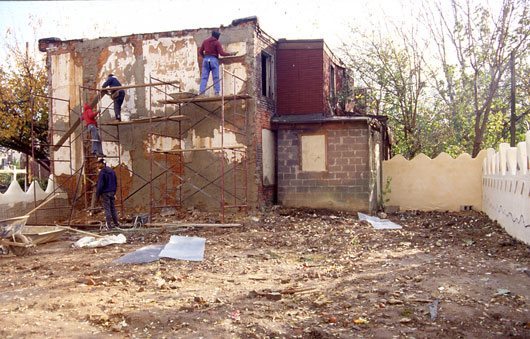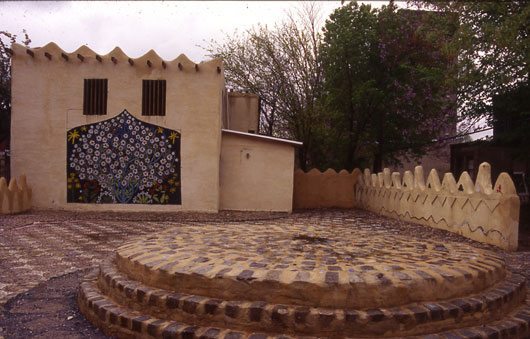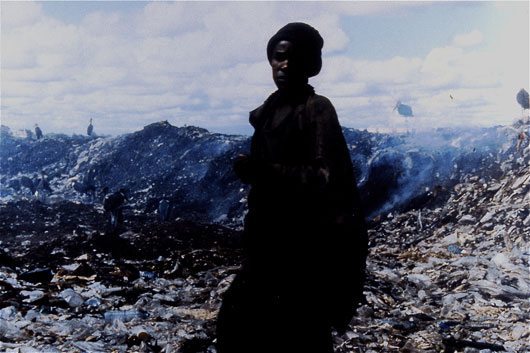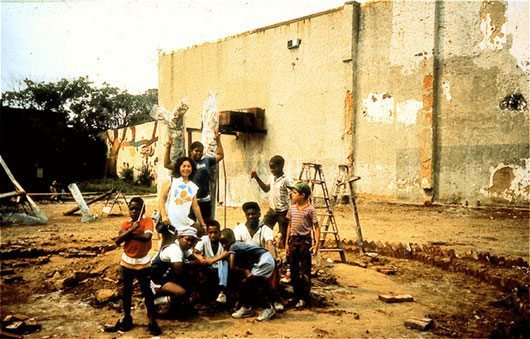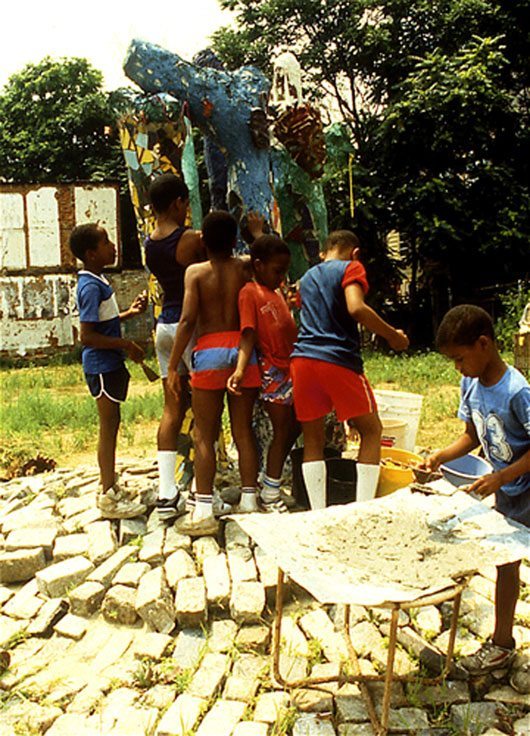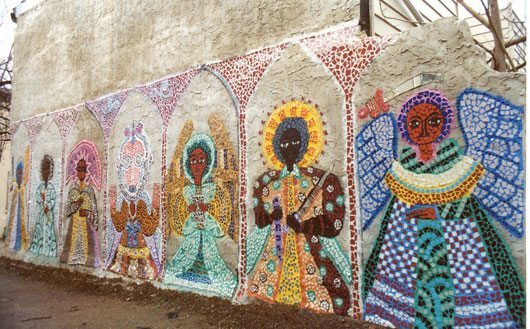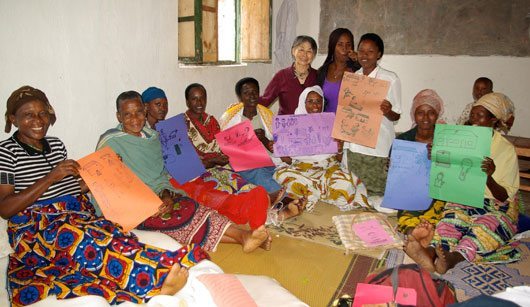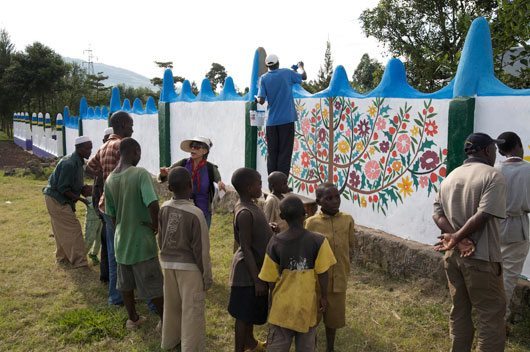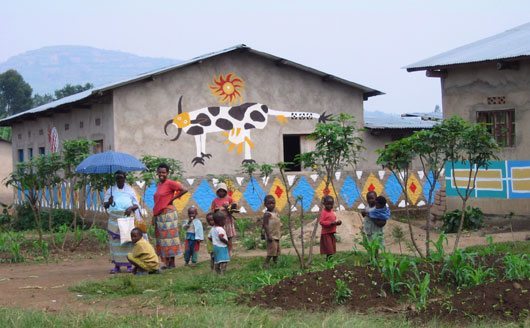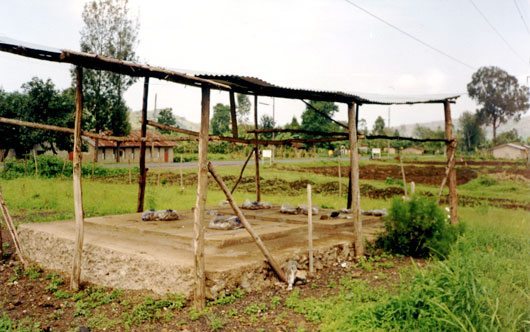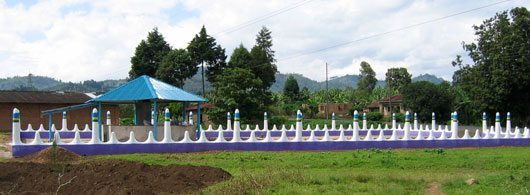Location: Philadelphia, Beijing, Rwanda
ABOUT LILY YEH
BORN IN CHINA IN 1939, LILY YEH CAME TO the United States in the early 1960s and attended the University of Pennsylvania’s Graduate school of Fine Arts. A very successful painter, she eventually became a professor at Philadelphia’s University of the Arts. Yeh returned to Beijing in 1989 to display her artwork at the Central Institute of Fine Art. While there, she witnessed the tragic events of Tianamen Square. Through the 1980s, Yeh came to realize that being an artist ‘is not simply about making art It is about delivering the vision one is given and about doing the correct thing without sparing oneself.’ She has continued pursuing her vision by way of her new organization, Barefoot Artists, Inc., which instructs residents and artists on how to replicate the Village model in damaged communities around the globe.
In 1986, Yeh was asked by noted Philadelphia dancer and educator Arthur Hall to create a park in an abandoned lot adjacent to his building. With a small grant, several shovels, and not much else, Lily invited resident children and adults in the run down inner city neighborhood to get involved with her to clear the rubble-filled lot. They subsequently transformed the space into an unique art park with bold mosaics and sculpted trees, creating an oasis of safety and peace.
MEDITATION PARK (AFTER), Lily YehThe park evolved and blossomed into The Village of Arts and Humanities, a local community-based organization which Yeh co-founded in 1989. Her colleagues and neighborhood residents have gone on to transform more than 200 empty lots in Philadelphia into parks and gardens. They’ve also renovated abandoned homes, begun educational programs, art workshops, after-school programs, a youth theater, and created community celebrations, involving thousands of low-income people.
One of the world’s most innovative urban designers and social pioneers, today Yeh’s vision has spread far beyond North Philadelphia’s borders. She continues to work to inspire and collaborate with prison inmates to create beauty and art, and has does the same with thousands of adults and children who live in some of the most tragic and broken communities in the world. She’s collaborated with community members of the Korogocho slums near Nairobi to transform a barren churchyard with murals and sculptures and traveled to Ghana, the Ivory Coast, Ecuador, and the Republic of Georgia to work on similar projects. Her most impressive initiative was the Rwanda Healing Project, where she’s worked with hundreds of children and families to transform their bleak, forlorn village into a rejuvenated place of beauty and joy.
KOROGOCHO, Lily Yeh, Vast Slum Project, 1994Yeh recently completed her first, soon released book, Awakening Creativity to be published in May 2011 by New Village Press. In it she details her experiences inspiring students of The Dandelion School, the only nonprofit organization in Beijing that serves the children of the many poor migrant workers coming from dozens of Chinese provinces, in artmaking. Working collectively with hundreds of students, teachers, volunteers and workers, the school’s main campus was transformed by the creation of mural paintings, mosaics, and environmental sculpture. Students became involved in every aspect of the art-making, which is now central to the school’s curriculum.
Terry Tempest Williams, author of many epic books, most recently Finding Beauty in a Broken World, and whom I was quite fortunate to interview for Progressive Magazine several years ago, (http://www.progressive.org/?q=node/334) calls Yeh ‘a global angel who not only believes in the power of people engaged, but inspires and ignites them through her own creative fire. Lily Yeh changed my life completely.’
DK: IN YOUR EXPERIENCE WHAT CAN ART DO TO HELP FIND SOLUTIONS TO COMMUNITY AND SOCIAL PROBLEMS?
LY: MAKING ART IS A SIMPLE ACT, DIRECT, accessible, and effective. It can take place almost in any place and circumstance. It does not cost a lot and can heal deeply. It creates a new space where people can express themselves and have their voices heard and where people can dream of possibilities and envision their future. It does not solve social problems directly but it creates an atmosphere which makes the healing and building of community and finding solutions to various social problems possible.
The process of making art in a community setting provides us opportunities to generate a new space, into which we can come on equal footing, each bringing in his/her talent, imagination. Through a collaborative and co-creative process we can envision our future according to our ideal without being shackled down by many of the existing problems. Once we are clear about our goals in the future, we might find innovative ways to solve or bypass the problems without being entangled in their predicament, which can drain our energy and makes us lose sight of the possible and the ideal.
I often ask myself how is art such an effective vehicle for community building and social change? Affirmative, inclusive, and non-competitive, making art together cuts through barriers of color, race, class, and gender. Through the opportunities it offers us in expressing who we are, our sensitivity and beliefs, art inspires and unites. It is political in that it empowers and gives voices to people. When deployed in the proper manner, art is a powerful tool in expressing democracy.
Making art in destitute situation is like making fire in the darkness of a winter’s night. It gives out warmth and light; it beckons and rekindles hope. It does not directly solve problems but it creates a fresh, nurturing environment in which new possibilities and methodology can emerge. This approach has worked for me in all the community-based projects I have launched in Ivory Coast, Kenya, Rwanda, China, and the United States.
DK: WHAT INFLUENCE DID YOUR UPBRINGING IN BUDDHIST AND TAOIST PHILOSOPHY HAVE ON YOUR COMMUNITY BUILDING WORK?
LY: PROFOUND, IT’S ALMOST LIKE IN THE BLOOD. I was born in China and grew up in Taiwan. All the students have to study Taoist and Confucius teachings in school. I had friends who were Buddhists. But in those days, it did not catch my interest. But after coming to the States, I found myself more and more drawn to its way of thinking and practices. All of them, Taoist, Confucius, and Buddhist teachings have affected me deeply.
The concept of Tao is best represented by the visual symbol of the circle composed of the Yin and the Yang elements. It suggests the two conflicting and yet complimentary forces in nature. Literally Yin means the shadowy side of things and Yang, the sunny side. They are in an eternal embrace and must always appear simultaneously. Since nothing stays still in nature; these two forces or elements strive constantly moving to become each other. Each element contains the seed of its opposite and will eventually become its opposite.
This understanding makes me see things differently. When I see the brokenness, poverty and crime in inner cities, I also see the enormous potential and readiness for transformation and rebirth. This understanding helped me to get started in my little summer art project on the abandoned land in North Philadelphia. This humble art project eventually evolved into a non-profit organization, The Village of Arts and Humanities.
The core teaching of Confucius is about ethics and the proper ways of treating each other to create a harmonious society. One of the central pillars in his ethics is compassion (? ren). One of the most famous sayings is ‘Do not do to others what you don’t want others do to you.’ His ideal of the great unity, da tong (??) has impressed deeply during my formative years. It says, ‘When the Great Way is practiced, all under heaven belongs to the people. Worthy and capable people are chosen, who speak with integrity and cultivate harmony. Thus people do not cherish only their parents, nor love only their own children. The elderly are cared for until death, the able provided with employment, and the children with sustainable means to grow up. Widows, orphans, childless, disabled, and infirm are given sufficient support. This is called the Great Unity.’
Buddhist teaching in its interconnectedness and transiency of life helped me to be able to live more in the moment and to feel the pain of the others. I don’t think learning on an intellectual level can lead to the feeling of compassion. But the awareness of my own inward ignorance rooted in the ego hood, which manifests in lust, greed, pride, aggression, and possessiveness, helps to dispel darkness of self- preoccupation. The opening of the heart makes possible the feeling of empathy and joy.
DK: HOW DID LILY THE ARTIST BECOME LILY THE LOCAL SOCIAL ACTIVIST? WHAT INSPIRED YOU TO TAKE ON THIS MISSION-BASED WORK?
LY: I GUESS IS THAT IT WAS DISSATISFACTION WITH my life that sent me searching. Searching for meaning and authenticity.
I actually had a very nice life. After I got my master degree from the University of Pennsylvania, I started teaching, first at West Chester College, now West Chester University, in Pennsylvania and then the University of the Arts in Philadelphia. I had a lovely family and exhibited at well-established galleries. During the 1970s and 80s, I traveled often to China and Europe. Somehow I felt something was missing. I remembered the words of Martin Luther King, Jr., ‘ A man who won’t die for something is not fit to live.’ I guess I was looking for something ‘a woman would die for.’
The opportunity came in 1986 when I was invited by the renowned African American dancer/choreographer Arthur Hall to create an art park on an abandoned lot next to his building in the heart of inner city North Philadelphia. Everyone told me not to go. ‘Kids will destroy everything you build.’ ‘You don’t have enough money. The grant you got is like a drop in the bucket. Do a feasibility study and forget about the building part.’ Also, the little lot expanded ten times in size. The city tore down the dilapidated houses adjacent to the lot and turned them all into one big piece of empty land. I was ready to quit but the little voice in me spoke, ‘If you don’t rise to the occasion, the best of you will die. The rest will not amount to anything.’ I was afraid to be a coward so I ventured into the inner city land and began the project. That was the moment when the artist in me became the activist.
Making art was no longer separated from life. Dilapidated places and broken communities became my canvas. People’s stories became the pigments, their talent the tools. Together we create something that is rooted in the community while expressing its struggles and aspirations. The art produced through this procedure is for the people, with the people, by the people, and at the end belongs to the people. Its process is embracive and democratic; its results nurture and build community. Social change happens and artists stand in the center of the change.
DK: WHAT OCCURRED FOR YOU TO CREATE YOUR FIRST GARDEN BACK IN 1986? WAS THERE SOME TURNKEY EVENT FOR IT?
LY: A TURNKEY EVENT FOR ME HAPPENED IN BEIJING in the months of May and early June of 1989 when I witnessed the unfolding of the Students’ Movement at Tienanmen Square. It was like being in the eye of an immense storm, which revealed history in the making. Quietly sitting in the middle of that enormous square, the students who went on the hunger strike triggered a powerful force, arousing the whole country and the world to support and rally behind their actions. In Beijing at that time, everyone became an artist expressing their feelings through action: writing poetry and prose, creating paintings and sculptures, participating in marches of people, motorcycles and trucks.
The country was on fire with new hopes, dreams, and intense emotions. The hunger strikers were students from Beijing and Qing Hwa Universities, the equivalent of Harvard and Yale in America. They were the cream of the crop and the chosen leaders of the future. Yet, in deciding to do the right thing, they did not spare themselves. That was where their power lay. They did not ask to change others. They simply took action themselves. They found something they would die for. That left an indelible mark on me.
DK: IT SEEMED LIKE A PROCESS OF THE CREATION OF THE MOSAICS HAS REALLY HELPED TO CREATE A SYMBOLIC FORM OF ARTWORK, TAKING THE BROKEN PIECES AND MAKING SOMETHING BEAUTIFUL. HOW DID THAT CREATION TRANSFORM THE VILLAGERS THAT YOU WORKED WITH?
LY: LIFE BREAKS PEOPLE; GENOCIDE CERTAINLY SMASHED and destroyed the lives of an enormous number of people. But life continues despite the enormity of the tragedy. How to help people to find the courage to go on is the question. Genocide created a huge crisis for individuals, families, and society. The word crisis in Chinese ?? signifies danger and opportunity. Brokenness provides us a new occasion to recreate.
The families that live in the Rugerero Survivors Village where we have worked for several years came from different places in Rwanda. After the genocide, many people were left traumatized, homeless, and destitute. Government constructed many villages for survivors to accommodate the poorest and most helpless. People lived together but remained very much alone. Not knowing the people in the village, they could not trust and share their grief. Each family suffered in its own solitude.
Making mosaics is a laborious process. It takes time and patience. Piece by piece, villagers placed mosaic tiles onto the wall; little by little, they began to gain faith in each other through collaboration. When beauty emerged at the end of the process, they saw the possibilities that their life could be made whole again through helping each other.
‘When we see beauty, we see hope. Working together helps us to heal our wounds. Future is possible now.’
DK: WHAT IS THE VILLAGE MODEL THAT YOU SAY YOU WORK TO REPLICATE IN DEVASTATED COMMUNITIES AROUND THE WORLD?
LY: UNDER THE AUSPICES OF BAREFOOT ARTISTS, I try to bring the transformative power of art to some of the impoverished communities in the world through participatory and multifaceted projects that foster community empowerment, improve the physical environment, promote economic development, and preserve and promote indigenous art and culture. As a norm, I collaborate with individuals and agencies on the ground in identified communities. Art in this context becomes a vehicle for amplifying and coordinating existing efforts through projects that inspire individuals and physically transform communities. The collective process used in these projects fosters community pride while allowing each participant to experience a sense of individual accomplishment.
People often ask me whether my work can be replicated. ‘Definitely,’ I say, ‘not so much in form but in intention and organic methodology.’ If the projects evolve organically, no two projects should look alike since their evolution will depend on their respective location, timing, resources, local culture, leadership, and the resolve of the people involved. But the underlying structure of the projects should be similar in their multi-faceted, multi-leveled, and inter-connectedness of the various components within. These projects need to contain the qualities of flexibility, openness, imagination, and innovative actions.
Often I feel myself as a rainmaker. How to create the right climate for the rain to come is the question. First there must be a need for the rain. The need drives the desire for change. Then the first step is to understand it. In my case, it is the need for an artist to create and to find meaning in her action. It is the need of the community for a better life and future.
The second step is to assess the reality and to know what is possible. For example, in arid places, one starts planting trees, maybe just a few if one does not have a lot of resources. Taking action, in my case, making art, is the beginning of building a new possibility. Once the trees are planted, it takes effort to nurture and sustain them. This is why people in the community must be an essential part of the project from the beginning for the work to be sustainable. If the first few trees begin to live and thrive, they will draw other forms of life, insects, birds, and small animals. If being attended to, the trees will multiply, maybe gradually into a tree grove and even a small forest. Then they have the possibility of creating moisture and attracting rain. The steps can be replicated to create success, but it will take patience, commitment, and resolve. This is the model I hope to replicate.
When the community has a good infrastructure then it will have the ability to receive help and put it to good use. Success breeds success. Demonstrating its ability to manage resources, the community is likely to get more aid and support from the society. This is what I call the art of rainmaking.
My work engages people, whose participation ensures its sustainability. This is why I call my art living social sculpture. It usually begins with making art with people; it then expands to include other activities such as storytelling, education, construction, and economic initiatives. The living fabrics of communities become the canvas of my work, creativity its fuel, people’s talent and imagination its palette and tools. In the poor communities where I have worked, this process often leads to an improved environment, a better quality life, and a sense of joy and hope for the future.
The second step is to assess the reality and to know what is possible. For example, in arid places, one starts planting trees, maybe just a few if one does not have a lot of resources. Taking action, in my case, making art, is the beginning of building a new possibility. Once the trees are planted, it takes effort to nurture and sustain them. This is why people in the community must be an essential part of the project from the beginning for the work to be sustainable. If the first few trees begin to live and thrive, they will draw other forms of life, insects, birds, and small animals. If being attended to, the trees will multiply, maybe gradually into a tree grove and even a small forest. Then they have the possibility of creating moisture and attracting rain. The steps can be replicated to create success, but it will take patience, commitment, and resolve. This is the model I hope to replicate.
When the community has a good infrastructure then it will have the ability to receive help and put it to good use. Success breeds success. Demonstrating its ability to manage resources, the community is likely to get more aid and support from the society. This is what I call the art of rainmaking.
My work engages people, whose participation ensures its sustainability. This is why I call my art living social sculpture. It usually begins with making art with people; it then expands to include other activities such as storytelling, education, construction, and economic initiatives. The living fabrics of communities become the canvas of my work, creativity its fuel, people’s talent and imagination its palette and tools. In the poor communities where I have worked, this process often leads to an improved environment, a better quality life, and a sense of joy and hope for the future.
DK: YOU SEEM TO SHARE YOUR SENSE OF JOY IN CREATING ART WITH SO MANY PEOPLE, WHOEVER WANTS TO BE PART OF THAT PROCESS REGARDLESS OF THEIR ARTISTIC BACKGROUND.
LY: I FEEL THAT IT IS A PRIVILEGE FOR ME TO WORK with people who have experienced a lot in life and want to share their stories. In the broken communities I work, people usually do not have much training in the visual art. It is challenging but also exciting because of the enormous potential that art making provides in this kind of situation. In Zen master Shunryu Suzuki’s words, ‘In the beginner’s mind there are many possibilities, in the expert’s mind there are few.”
I often imagine the time when human beings lived in a world before language was created. Trying to convey their experiences, for example, the lovely color in the sky, they finally managed to find the right sound, say blue, or lan in Chinese, to express their feelings. Imagine the power of the word. It summarized people’s sense of wonder, awe, and mystery of the sky. I feel that it is the same with the visual images. Whatever people’s artistic background, their visual images become potent when filled with feelings.
When the storytellers have no existing forms or formulas, they have to struggle to find the right images to express their emotions. This is when the visual images become authentic and charged with meaning. When people find the right images to express their experiences, they feel a sense of joy and accomplishment. For me, working with people in this process keeps me in contact with the fountainhead of creativity. It is a blessing.
DK: YOU DON’T NECESSARILY HAVE TO SEE THE RIPPLES HITTING THE EDGE OF THE POND, THE FULL IMPACT OF YOUR EFFORTS?
LY: WHEN PEOPLE SEE THE TRANSFORMATION OF THE environment at the Village of Arts and Humanities, from trash-filled lots to beautiful art parks, gardens, play spaces, vegetable gardens, and a tree farm, they are amazed. I always tell people that yes, the results are wonderful, but the process was even more wonderful. It was the realness of human interaction in its undisguised nakedness that drew me back at the beginning of the project. Once I experienced that, I would always search for places, communities where my work would generate meaningful interaction and collaborations. Authenticity nurtures and deepens. That is reward enough. I don’t need to see the ripples hitting the edge of the pond.
DK: THEY ARE ABLE TO TRANSFORM THEIR OWN SPIRIT THROUGH ENGAGING THEIR ARTISTIC SKILLS.
LY: CREATIVITY BRINGS NEW POSSIBILITIES TO OUR lives. We all have it within us. When we are connected to the fountainhead of creativity, we become empowered. Although I was trained as a visual artist, I define art as creativity in thinking, methodology, and implementation. Making art is about honoring ourselves through expressing who we are, daring to think outside of a box and taking action to realize our ideals. We cannot remake the past, but we can shape our own future. When we allow our mind the freedom to imagine, employ our innovative skills to carry out our dreams, we can transform our spirit, through this process, to hope and joy.
DK: WHAT HAS BEEN THE ROLE OF ENGAGING CHILDREN IN YOUR WORK?
LY: ESSENTIAL! FOR THE FIRST THREE YEARS AT the Village of Arts and Humanities, with the exception of Jojo, no adults came. Our summer workshops were filled with hordes of children from 3 and a half to 14 years of age. They were curious, energetic and ready to engage. At that time, there was very little for children to do in the neighborhood. Seeing that Jojo and I were having fun poking about in an abandoned lot, they wanted to join in. That was how it all started. Through working with the children on park building, we earned the trust of the adults in the neighborhood. Some came in for jobs. Let was how an adult work program started. So working with children is indispensable in my work. Breaking down barriers, their energy and enthusiasm help build community. Mahatma Gandhi said, ‘we are to reach real peace in our world, we shall have to begin with children.’
DK: WHAT IS THE ROLE OF COLLECTIVE VISIONING BEFORE THE ACTION TAKES PLACE IN YOUR INDIVIDUAL ART PROJECTS?
LY: IF ONE IS SERIOUS ABOUT COMMUNITY WORK, THEN the collective visioning is an crucial tool. I learned that very gradually. At the beginning I went in as an artist I said I wanted to this. Then I found out that people have talent and imagination and often could do things better than what I have planned. It is a process of building trust, empower and letting go. Community envisioning helps the project to take roots in the community, be nurtured and develop according to its particular situation. It definitely helped in the success of the Rwanda Haling Project.
In 2006 after people in the Rugerero Survivors Village experienced the joy of working together in transforming their own environment, they felt energized and optimistic. My colleague Jean Bosco Musana, Coordinator of Red Cross in West Rwanda, and I organized a community meeting for people to envision their future together. Over 120 survivors participated. They listed their needs and projected the possibilities of a future when they would have jobs, health care, training for adults, care for the old, and education for the young. They suggested means of organization and prioritized their wishes. This inclusive process strengthened and unified the community and charted a map for community building in the Survivors Village.
When I launched the Dandelion School Transformation Project on the outskirt of Beijing, I went through a similar process. My goal was not only to transform the environment of the school but also to engage its 670 students and teachers in its process. I used several methods to reach this goal, including training for teachers, workshops for students, on site implementation, and community envisioning. Many images emerged from the collective envisioning process were incorporated into the public art designs which changed the sterile, factory-like school into an inspiring environment filled with brightly painted images and mosaics.
DK: DESCRIBE WHAT SOME OF THE GARDENS YOU CREATED LOOK LIKE.
LY: MY GARDENS ARE DIFFERENT FROM EACH OTHER in design, layout, and texture. What they all share in common is that there is an organic quality about them. They adapt themselves to the existing spaces, nestling into the neighborhood that feels natural and congruous. These art places do not impose themselves into the spaces. We never tore things down in order to build a garden/park. We built only on abandoned lots with the design adjusting to the existing situation. When the adjacent dilapidated houses were cleared away, then the garden/park would grow accordingly.
The gardens/parks that I designed usually have bold, colorful images. Folk art from all over the world, children’s art, and art of ancient times and faraway places inspire my work. Chinese gardens, African vernacular structures, and Islamic architecture hold a spell over me. I think the public spaces that I have created reflect their influences.
Although I am influenced by world culture, my artistic sensitivity roots deeply in the Chinese landscape painting tradition. The Village of Arts and Humanities is an example, where I have designed twelve public art spaces during the 18 years I worked there. Those spaces included parks, gardens, alleyways, a play space, and a tree farm. Even though the gardens I designed looked nothing Chinese, but walking through the Village reminded me of walking through a Chinese garden. There is no formal entrance. Different passageways lead one into the garden complex of the Village. As the paths meandering through the few square block area, vistas open up often when one thought that one faces a dead end. I remember the words ??, meaning exploring mystery, carved sometimes over the moon gates in some of the Chinese gardens. In a way, walking through the Village gave me the same impression. Wonder and surprises reveal themselves as one walks through the space.


